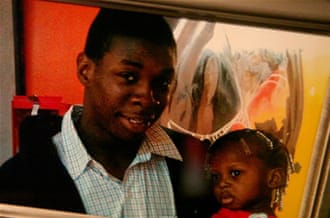 Chicago, US - A stack of glossy images showing an active and smiling young man is all that's left for Darius McGraw's family to remember him by.
Chicago, US - A stack of glossy images showing an active and smiling young man is all that's left for Darius McGraw's family to remember him by.On a cold morning in November 2012, 22-year-old McGraw was gunned down while walking to the home of his fiancée on Chicago's Southwest Side to pick up the couple's two-year-old daughter, Harmony.
"You could tell he was a loving father," said 58-year-old Arthur McGraw, remembering his son. "[Harmony] was his life."
The McGraw family said they weren't sure who killed Darius, but they were not alone in being forced to mourn a loved one slain in the US' third largest city last year.
According to a website set up by The Chicago Tribune to track homicides in the city, 513 people were killed in Chicago in 2012, most by gun violence.
The number is 15 percent higher than the previous year, and higher than more populous cities such as New York and Los Angeles - where the homicide rate has been decreasing in recent years.
Chicago authorities say gangs are to blame for the increase in deadly violence, and much of which is happening just minutes away from US President Barack Obama's Chicago home.
But family members said Darius, who was well known in the community as an activist and breakdancer, did not belong to any gang and encouraged other youth to stay away from them.
"Darius worked with all the young people in the community, teaching them how to breakdance and trying to teach them some values in life," his father said.
"He just tried to help, because he knew it was rough out here on the streets of Chicago."
'Most are good'
To try and combat the violence, Chicago Mayor Rahm Emanuel's office announced the launching of a Gang Violence Reduction Strategy in May.
The strategy will use more high-tech means to gather intelligence on dozens of gangs across the city, which can then be shared more easily between police districts, the mayor's statement read. It also sought to target "problem" businesses, such as "liquor and convenience stores that serve as conduits for criminal activity".
"Whether it is a vacant building or a liquor store, we are committed to closing down cancers on our communities that serve as magnets for crime and gang activity," Emanuel said at a July press conference.
While the strategy hasn't managed to reduce killings citywide, in the South Side Englewood neighborhood, infamous for being one of the city's deadliest, Chicago police say the situation is improving.
Deputy Chief Leo Schmitz told Al Jazeera that killings were down by almost 40 percent in his seventh district. He said this is due not only to the mayor's violence reduction strategy, but that his police force sought to engage people in the community to understand the problems "and not just see people when we’re racing into a call".
Schmitz said that "most people are good in Englewood", adding that he works closely with pastors, local officials, school principals and other community figures to put an end to the violence.
"There isn’t one answer" to keeping the violence in the district down, Schmitz said.
"The police just can't make things happen themselves. We [need] a partnership with everybody together to make things work here in Englewood."
Devastated communities
But not everyone sees more policing as part of the solution to the violence.
"The reason why the violence is getting worse is because more and more resources are being taken away from our communities," said Chris Bufford, a 26-year-old community activist who worked with Darius at the Southwest Youth Collaborative (SWYC).
In October, SWYC - one of the few organisations of its kind on the Southwest Side - was forced to close due to a lack of funds.
Bufford described SWYC as a space where many young people from the community would get services such as mentorship and tutoring. "And that's no longer there for them," he said.
In largely Black and Latino areas on Chicago's South and West Sides, where most killings occurred in 2012, it's common to see empty lots and boarded up homes and shops on nearly every street. In many neighbourhoods, liquor stores are some of the only places that can be found open.
"If we invest in our communities, in the housing, in the schools, in a justice system that helps to rehabilitate people, in the people that we say are causing all the trouble in our communities … I guarantee violence would be reduced," Bufford said.
But, for now, that investment doesn't appear to be taking place. And already in the first week of 2013, 12 people were killed in Chicago - putting the new year on track to be as deadly as the last.
"If you don't give [young people] nothing to do, they will turn to the gang members as their family," said Arthur McGraw, Darius' father.
As a police siren blared in the background, McGraw added: "It's just devastating to see your child get killed on the streets."
Original Article
Source: aljazeera.com
Author: Matthew Cassel
No comments:
Post a Comment